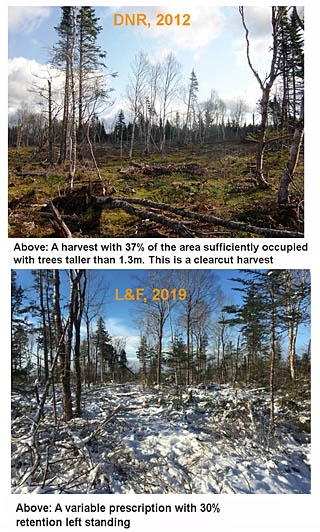
Is some of the progress semantic? Top figure from DNR: An operational clearcut definition (2012), bottom from L&F Forestry Maps, 2019
L&F stopped using the term clearcut in 2019.
Click on image for larger version
In a recent CBC interview, the L&F Minister of Lands & Forestry was asked how he would “evaluate the progress L&F has made since the Lahey Report was submitted 2 years ago and “what is a reasonable expectation for the public in terms of when they might start seeing some measurable progress on some of the larger goals in this report?”
The Minister responded:
The progress has been significant when you look at the resources that have been put into the project teams and the fact that most recommendations are advancing out of the 45…we are seeing a lot more long-lived shade-tolerant species being left on the ground which is a cost to government and to industry, they have had challenges around that, they not as vocal as the side that wants to see no clearcutting. (From Abbreviated Transcript)
In this (Part 1) and two subsequent posts, I will give my evaluation of or at least my thoughts about the Minister’s response.
I offer these comments as one who has no special access to the department; they are based on what I am able to glean from whatever information is available on the L&F website, from what I see on the ground (and/or in and other satelliteGoogle Earth images), what I see in the press and on publicly available social media, talking to people including some foresters on both sides of the debates, and declaring my conservation-oriented bias.
I offer these comments partially in the hope that they will stimulate the Minister/L&F to be more communicative with the public, to be sensitive to and informed by concerns expressed by those of us they see as ‘vocal’.
In this post, I comment on the second part of the Minister’s response: “we are seeing a lot more long-lived shade-tolerant species being left on the ground which is a cost to government and to industry, they have had challenges around that, they not as vocal as the side that wants to see no clearcutting.”
Re: the cost to government and industry. It sure would be nice to see an independent and comprehensive accounting of government expenditures/income related to government/taxpayers’ support of the forest industry in NS, and how that is being changed by “leaving a lot more long-lived shade-tolerant species on the ground”.
What would be the cost to government of simply not allowing any logging on Crown land?
The true cost of government/taxpayers’ support of Northern Pulp over the years is now becoming painfully evident. What are the past and ongoing costs and financial benefits of our direct and indirect support of our sawmills?
We could ask the accountants to go a step further and include the long-term costs and benefits associated with gains or losses of Ecosystem Services, the services that healthy ecosystems provide free of charge (e.g. water purification, erosion control, pest control, tourism attractions) but that we have to provide and pay for when we lose those systems. However, even a here-and-now accounting would be welcomed – for now.
Re: “a lot more long-lived shade-tolerant species being left on the ground”. It sure would be nice to see some supporting stats and images from L&F, as there is a widespread perception that ‘not much has changed on the ground’.
Shelly Hipson calculated from her compilation of stats provided to subscribers of new Crown land harvest plans that “88% of all of the cuts [on Crown lands] that have come in the last approximate year and a half right up to Aug 4 has been clearcuts” (view NSFN post Aug 13, 2020, a figure that has not been refuted by L&F; details of her compilation of figures for all of 2019 are shown here.
Note that Shelly Hipson (and most foresters) regard “Variable Retention” cuts as clearcuts/eve-aged management. That might be arguable from L&F’s perspective which no longer uses the term “clearcut”, however Variable Retention cuts of 10-30% would be considered “clearcuts” by L&F’s own definition
A clearcut is a forest harvest where less than 60% of the area is sufficiently occupied with trees taller than 1.3 metres
The Minister maintains that “these are the trees [the 10-30% retained in Variable Retention cuts] that are most important to retain to shift the focus from single-age management to multi-aged management.
OK, that is a nice thought, but when you cut 70 to 90% of the stand, it is a stretch to imply that it is multi-aged management, not to mention that when 70 to 90% of the stand is cut, a lot of blowdown of those remaining trees could be expected.
Fear of blowdown has been a major route to clearcutting in the past when otherwise other treatments might be considered (re the current Forest Management Guide). What are L&F’s directives to avoid blowdown of the retained trees?
Variable Retention is also kicking the real decision about whether to actually change direction from even-aged management to multi-aged management 30+ years down the line.
I am guessing that is well past the lifetime – and accountability – of the current government.
——-
I would welcome a contrary perspective from L&F/the forest industry and am willing to post such a perspective here as a Guest Post (or 2 or 3 Guest Posts). Shorter comments can be made on Woods and Waters Nova Scotia (public Facebook page) either attached to a post that the host (Mike Parker) makes about this post, or as a comment made with reference to this post.
